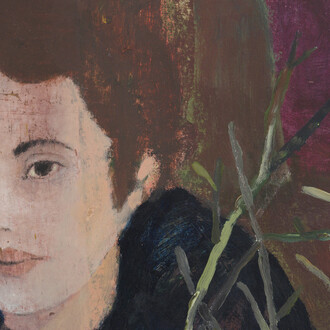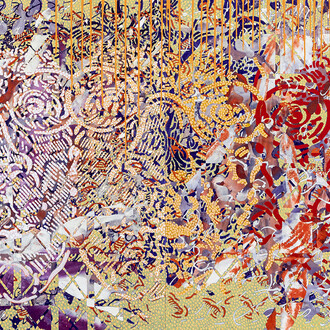‘I want to be a Name, not a master’ wrote Isidore Isou in 1947. Since his arrival in Paris in 1945, at the age of twenty, Isou had already made a name for himself. He met figures from the intellectual sphere such as André Breton, André Gide or Tristan Tzara, with and against whom he positioned himself as one of the last champions of avant-gardism. With Gabriel Pomerand, he founded Lettrism, proclaimed in 1946 during a controversial performance at the Vieux-Colombier theatre. With support from Jean Cocteau and Jean Paulhan, Isou published La Nouvelle Revue française in 1947. His theoretical essay Introduction à une nouvelle poésie et à une nouvelle musique [Introduction to a New Poetry and a New Music] laid down the foundations of Lettrism. In it, Isou described the phase of disintegration poetry had entered since Baudelaire and declared the advent of the letter, the ultimate step in this purification process. The letter and more generally the sign represented for Isou the possible basis of a total renewal of the arts.
A compulsive writer, Isou drafted hundreds of works revealing the extension of his considerations into other disciplines. Visual arts, architecture, politics, economy, mathematics, medicine, psychology or erotology were measured against the yardstick of ‘Kladology’, an invented method applicable to all branches of culture. In 1976, his works were summarised in a vast theoretical publication, La Créatique ou la Novatique [Creativity or Novelty].
Throughout his life, Isou surrounded himself with companions with whom he could test his theories and produced a significant body of work. Certain figures, such as Maurice Lemaître, would remain life-long friends and were to play a decisive role in Lettrist productions. Others, such as Guy Debord, paid a more fleeting part in the movement, drawing valuable lessons from it. Isou invented numerous and often pioneering concepts, his work and his thought unquestionably announced a certain number of the great turning points in the history of art. ‘Hypergraphy’, ‘meta-aesthetics’, ‘infinitesimal art’ or the ‘super-temporal frame’ thus corresponded to fundamental practices in late 20th century art. Isou’s influence is also perceptible in other fields, the vital role he assigned to youth in his political theory was echoed in Situationist thought and the demands of the 1968 uprising. Stemming from archives recently acquired by the Centre Pompidou, the exhibition aims to reveal all the wealth of this decidedly unique body of work.
















